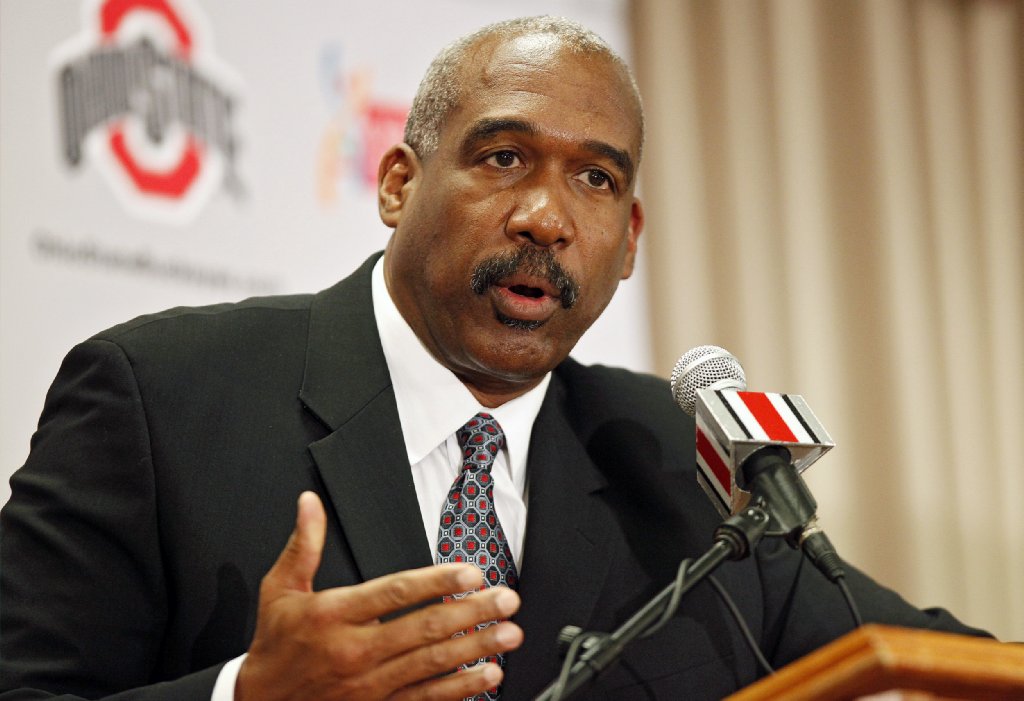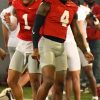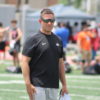
When Ohio State athletic director Gene Smith stepped up to the podium at the Woody Hayes Athletic Center Wednesday morning, many in attendance assumed that he would spend the majority of his time commenting on the constantly-evolving landscape of college football and the Big Ten Conference.
Instead, the recent news of conference realignment served to be a distant afterthought in the Ohio State team room, as the 69-year-old Smith announced he will retire next summer, effective June 30, 2024.
Speaking in front of a packed room of media members for just over 50 minutes, Smith reflected on the 18 years he has spent leading Ohio State’s athletics department, recounting the many moments — both good and bad — that helped define his nearly two-decade Buckeye tenure.
When asked to describe his biggest accomplishment at Ohio State, Smith said he takes the most pride in the way he and his staff were able to mold its student-athletes into high-character individuals and better prepare them for life after college. This, according to Smith, was not an easy task to achieve.
“I’m most proud of the fact that we’ve been able to create a culture where we develop the student-athlete holistically,” Smith said. “And that means so much to me, it really does. It took us a little bit to transition to that, to make sure that, when that student-athlete leaves our little cocoon, she or he is ready, they’re ready for their next chapter in their lives. And we didn’t do that well when I first came, we didn’t.”
“And I have to compliment my teammates and everybody, because they all embraced that vision of making sure we challenge the student-athlete early in their career, their freshman year and sophomore year, to make them figure out what path they might want to be on,” Smith continued. “So I’m most proud of that. Our kids have great character. They’re really great people. And that’s cool.”
Smith specifically pointed to the 2022-23 academic year as a prime example of these efforts coming to fruition, where his Ohio State student-athletes succeeded at historic rates both in their respective sports and in the classroom.
“This past year, we witnessed unprecedented performances,” Smith said. “(Ohio State) finished third in the Directors’ Cup. 95 percent of our graduates found jobs and performed professional work, or (are going) to graduate school. We had our best Academic Progress Rate score in history of 993. So it was a phenomenal year for our student-athletes.”
While Smith took pride in his ability to transform his athletes into “future leaders” beyond the world of collegiate sports, he also noted some individual and team performances that positively impacted his time as Ohio State’s athletic director.
“You know, there are so many great moments,” Smith said. “The (2014) national championship in football, that team was special. The three national championships in volleyball, men’s volleyball, (in 2011, 2016 and 2017) were special. The wrestling national championship (2015) was unreal. I think I was in North Carolina for women’s basketball, and I had to fly to St. Louis in order to catch that, to see those young men perform. So there’s been championships.”
“And (there have been) individual student-athletes who have just been so impressive,” Smith continued. “(11-time All-American and two-time national champion) Christina Manning, in track, she was just fun to watch. There’s just so, so many of those.”
Although Smith alluded to the many achievements he had since arriving at Ohio State in 2005, he also revealed some of the more challenging moments he endured during his Buckeye career.
Smith was quick to point out the 2011 football season as a significant dark period of his Buckeyes tenure, where the NCAA suspended Ohio State players Mike Adams, Daniel “Boom” Herron, DeVier Posey, Terrelle Pryor, and Solomon Thomas for selling off their memorabilia and receiving improper benefits from a tattoo parlor. The scandal, which is now more commonly known as “Tattoo-Gate,” forced Ohio State to vacate 12 wins from the 2010 season along with a Big Ten and Sugar Bowl championship, and seemingly led to the resignation of former head coach Jim Tressel.
“2011 was hell,” Smith said. “That was painful. The student-athletes who were impacted didn’t deserve the penalties that they had to deal with. That was hard. People were affected negatively, and that was a hard time. And so helping (2011 head coach) Luke Fickell through that year was hard, that was really challenging. And I have to compliment him for his resilience and his commitment, and his stick-to-itiveness to try and keep our program afloat. So that was a hard year, the dog years.”
Smith also alluded to the 2020 season as another “hard year,” as he was forced to lead an athletic program amid the global COVID-19 pandemic. He also mentioned the beginning of the 2018 football season, where both he and former head coach Urban Meyer served suspensions after an investigation confirmed Meyer was aware of domestic violence abuse allegations made against wide receivers coach Zach Smith in 2015.
Despite the few pitfalls during his long career in Columbus, Smith is confident that he — and the people who worked alongside him — have fostered a positive culture within the Ohio State athletics department that the new regime can build upon starting in 2024.
“I’ve always wanted to leave a place better than I found it,” Smith said. “But I also want to leave a place that, when a next person comes in, gives them a chance to transition in as smooth as possible. And they now have that ability with this team. And it always wasn’t that way. We’ve been unstable a little bit. So now it’s a situation where they’ll come in, and they’ll make changes based on their style. But they’ll still be able to come in and take their time on the learning curve, and allow the team to work. And then they ultimately will make the changes they need to make.”








